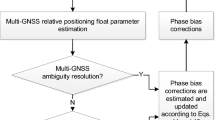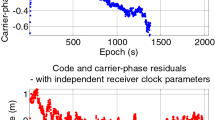Abstract
High-precision navigation using low-cost handsets has profound potential for mass-market applications, which has been being boosted by the release of raw GNSS data from Google Android smart devices. However, integer ambiguity fixing for centimeter-level GNSS positioning is prevented by the unaligned chipset initial phase biases (IPBs) found within Android carrier-phase data. In this study, we thus investigate the temporal behaviors of those chipset IPBs using zero baselines where smart devices are linked to external survey-grade antennas, and find that the IPBs are generally stable over time as the mean standard deviation of single-epoch IPB estimates derived from continuous carrier-phase data is as low as 0.04 cycles for all satellites. Unfortunately, these chipset IPBs differ randomly among satellites and change unpredictably if carrier-phase signals are re-tracked, discouragingly suggesting that the chipset IPBs cannot be pre-calibrated or even calibrated on the fly. We therefore have to presumably correct for them in a post-processing manner with the goal of inspecting the potential of Android GNSS ambiguity resolution if hopefully the IPBs can be gone. For a vehicle-borne Nexus 9 tablet with respect to a survey-grade receiver located 100–2000 m away, we achieve the first ambiguity-fixed solution within 321 s and finally 51.6% of all epochs are resolved; the ambiguity-fixed epochs can achieve a positioning accuracy of 1.4, 2.2 and 3.6 cm for the east, north and up components, respectively, showing an improvement of 30–80% compared to the ambiguity-float solutions. While all smart devices above are connected to external survey-grade antennas, we find that a Xiaomi 8 smartphone can be coupled effectively with a miniaturized portable patch antenna, and then achieve commensurate carrier-phase tracking and ambiguity-fixing performance to those of a commercial μ-blox receiver with its dedicated patch antenna. This is encouraging since a compact and inexpensive patch antenna paired with smart devices can promote the democratization of high-precision GNSS.











Similar content being viewed by others
Data availability statement
All data collected for the study are available from the authors by request.
References
Banville S, Diggelen FV (2016) Precise GNSS for everyone: precise positioning using raw gps measurements from android smartphones. GPS World 27(11):43–48
Eueler HJ, Goad CC (1991) On optimal filtering of GPS dual frequency observations without using orbit information. Bull Géod 65(2):130–143
Euler HJ, Schaffrin B (1990) On a measure of the discernibility between different ambiguity solutions in the static-kinematic GPS mode. In: Schwarz KP, Lachapelle G (eds) Kinematic systems in geodesy. Surveying and remote sensing. Springer, New York, pp 285–295
European GNSS Agency (2017) Using GNSS raw measurements on Android devices. Publications Office of the European Union, Luxembourg
Geng J, Meng X, Dodson AH, Ge M, Teferle FN (2010) Rapid re-convergences to ambiguity-fixed solutions in precise point positioning. J Geodesy 84(12):705–714. https://doi.org/10.1007/s00190-010-0404-4
Geng J, Li G, Zeng R, Wen Q, Jiang E (2018) A comprehensive assessment of raw multi-GNSS measurements from mainstream portable smart devices. In: Proceedings of the ION GNSS+ 2018, Institute of Navigation, Miami, FL, USA, September 24–28, pp 392–412
Geng J, Jiang E, Li G, Xin S, Wei N (2019) An improved Hatch filter algorithm towards sub-meter positioning using only android raw GNSS measurements without external augmentation corrections. Remote Sens Basel. https://doi.org/10.3390/rs11141679
Håkansson M (2018) Characterization of GNSS observations from a Nexus 9 Android tablet. GPS Solut 23(1):21. https://doi.org/10.1007/s10291-018-0818-7
Hauschild A (2017) Basic observation equations. In: Teunissen PJG, Montenbruck O (eds) Springer handbook of Global Navigation Satellite Systems. Springer, Cham, pp 561–582
Humphreys TE, Murrian M, Diggelen FV, Podshivalov S, Pesyna KM (2016) On the feasibility of cm-accurate positioning via a smartphone’s antenna and GNSS chip. In: Proceedings of the IEEE/ION PLANS 2016, Savannah, GA, April 11–14, pp 232–242
Li G, Geng J (2019) Characteristics of raw multi-GNSS measurement error from Google Android smart devices. GPS Solut 23(3):90. https://doi.org/10.1007/s10291-019-0885-4
Malkos S (2016) User location takes center stage in new Android OS: Google to provide raw GNSS measurements. GPS World 27(7):36
Misra P, Enge P (2006) Global Positioning System: signals, measurements and performance, 2nd edn. Ganga-Jamuna Press, MA
O’Driscoll C, Petovelle M (2010) GNSS solutions: carrier-phase and its measurement for GNSS. Inside GNSS 5(4):18–22
Paziewski J, Sieradzki R, Baryla R (2019) Signal characterization and assessment of code GNSS positioning with low-power consumption smartphones. GPS Solut 23(4):98. https://doi.org/10.1007/s10291-019-0892-5
Pesyna KM, Heath RW, Humphreys TE (2014) Centimeter positioning with a smartphone-quality GNSS antenna. In: Proceedings of the ION GNSS 2014, Tampa, FL, USA, September 8–12, pp 1568–1577
Pesyna KM, Kassas ZM, Heath RW, Humphreys TE (2015) A phase-reconstruction technique for low-power centimeter-accurate mobile positioning. IEEE Trans Signal Process 62(10):2595–2610
Pirazzi G, Mazzoni A, Biagi L, Crespi M (2017) Preliminary performance analysis with a GPS+Galileo enabled chipset embedded in a smartphone. In: Proc. ION GNSS 2017, Institute of Navigation, Portland, Oregon, USA, September 25–29, pp 101–115
Realini E, Caldera S, Pertusini L, Sampietro D (2017) Precise GNSS positioning using smart devices. Sensors Basel 17(10):2434
Riley S, Lentz W, Clare A (2017) On the Path to Precision - Observations with Android GNSS Observables. In: Proc. ION GNSS 2017, Institute of Navigation, Portland, Oregon, USA, September 25–29, pp 116–129
Takasu T, Yasuda A (2010) Kalman-filter-based integer ambiguity resolution strategy for long-baseline RTK with ionosphere and troposphere estimation. Proc Int Tech Meet Satell Div Inst Navig 7672(6):161–171
Teunissen PJG (1995) The least-squares ambiguity decorrelation adjustment: a method for fast GPS integer ambiguity estimation. J Geodesy 70(1):65–82. https://doi.org/10.1007/BF00863419
Zhang Y, Yao Y, Yu J, Chen X, Zeng Y, He N (2013) Design of a novel quad-band circularly polarized handset antenna. In: Proceedings of the international symposium on antennas & propagation, Nanjing, China, October 23–25, pp 146–148
Zhang X, Tao X, Zhu F, Shi X, Wang F (2018) Quality assessment of GNSS observations from an Android N smartphone and positioning performance analysis using time-differenced filtering approach. GPS Solut 22(3):70. https://doi.org/10.1007/s10291-018-0736-8
Acknowledgements
This work is funded by National Key Research and Development Program of China (No. 2018YFC1504002) and National Science Foundation of China (No. 41674033). We used Google GnssLogger apps and Geo ++ RINEX Logger apps to obtain raw GNSS data from smart devices. We thank two anonymous reviewers for their valuable comments.
Author information
Authors and Affiliations
Contributions
JG conceived the project and the main conceptual ideas. JG and GL worked out almost all of the technical details and performed the numerical calculations for the suggested experiments; GL analyzed the data; JG and GL wrote the paper. All authors provided critical feedback and helped to shape the research, analysis and manuscript.
Corresponding author
Rights and permissions
About this article
Cite this article
Geng, J., Li, G. On the feasibility of resolving Android GNSS carrier-phase ambiguities. J Geod 93, 2621–2635 (2019). https://doi.org/10.1007/s00190-019-01323-0
Received:
Accepted:
Published:
Issue Date:
DOI: https://doi.org/10.1007/s00190-019-01323-0




